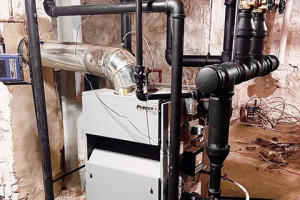
Hello, old friend. I’m writing today to say thanks, and to say farewell. This will be my last column.

"They don't live in the building. They never complain because they have nothing to complain about. They don't have agents, and best of all, they pay their rent on time."
That’s how he described them.
I was sitting in a conference room in Brooklyn, NY when the guy made those comments. He and I had just watched a series of PowerPoint slides that showed a drop of 35% and 38% in the fuel bill of two buildings at Columbia University. And along with those fuel savings came a record-low number of heat complaints from the actual tenants. I was sitting up straighter.
“That’s like having three more tenants!” the guy who makes his living buying and renting apartment buildings said. “That’s the way I see it.”
Others of us in the conference room had been talking about fuel savings in terms of dollars. How much invested vs. how much saved. You know, payback time. We focus on that because most of us think that building owners care only about that. How much will it cost up front? How long will it take me to get my money back? But this guy was telling me something new. It was a perspective I had never considered.
But first I have to mention that I act as a casual advisor to the people who came up with the product that created the three invisible tenants. I advise them because they asked, and because I really like hanging out with people who are way smarter than I am and who don’t know that certain things can’t be done. These people just go ahead and do those things anyway..
This started a couple of years ago when Google sent me an alert about a new product that was getting a lot of attention. The product was from a just-formed company called Radiator Labs. The product at the time was an insulated sack that fit over the top of a radiator. It looked sort of like a heavy pillowcase and it wasn’t pretty. There’s was a flexible hose inside the sack that extended from floor level to the top of the sack. There was also a small fan at the bottom of the hose to move the hot air from inside the sack to the room. The idea is to hold the hot air inside the sack until you need it.
This idea came to Marshall Cox, the founder, when his brother came to visit him at Marshall’s steam-heated, New York City apartment. Marshall’s brother was sleeping on the floor near the radiator and sweltering from the heat the iron beast was pounding out. So he opened the window, which made him cold, of course. Then he closed the window and went back to sweating. Marshall arrived, took a quilt off his bed, wrapped up the radiator, solved the immediate problem and got the idea for Radiator Labs.
Sure, it wasn’t a new idea. I sent Marshall a pen-and-ink drawing from the 19th Century of a Victorian radiator enclosed in what looks like a quilted tea cozy. The cozy has drawstrings on the side that a Victorian could use to raise or lower the fabric, thus controlling the amount of heat in the room.
Marshall liked the drawing and decided to call his new product, The Cozy.
He asked me to come and see him and I told him that I thought he was nuts and reinventing the wheel because we have had, since the 1920s, this device called a thermostatic radiator valve, which achieves the same purpose. So there.
But then the Massachusetts Institute of Technology, a place I hold in awe, awarded Radiator Labs its 2012 Clean Energy Prize and gave Marshall $200,000 to further develop the idea. He now had my full attention.
Last May, Popular Science magazine gave him their Invention Award. And along with that came even more attention from the media and from building owners. At that point, I figured it was time for me to stop being so arrogant, so I shut up and started listening more.
Although Marshall is very young, he holds a PhD in Electrical Engineering from Columbia University and a bunch of patents on things that have nothing to do with heating. He is smarter than I am but I know a lot about old heating systems. He asked a lot of questions and paid me back by sharing his ideas. If you look at the Radiator Labs site you’ll see how quickly The Cozy has developed because this guy thinks quickly and not like most people I have met. The Cozy is now sleek and it can also talk to a boiler, telling it what’s going on in each room. And if you have a smart phone, you can talk back to The Cozy, telling it what you would like. This got me thinking about the Nest thermostat, but with a twist because The Cozy works in old, steam- and hot-water-heated apartment buildings by zoning individual rooms and saving lots of fuel overall.
So there we are in the Brooklyn conference room, going over the latest findings. Most of the people in that room are young enough to be my children and all are smarter than I am. At one point, Meg Sutton, who is Radiator Labs data scientist, showed me the temperature data from the Columbia buildings and asked, “Dan, does this anomaly here mean this radiator trap has failed?” I looked at the paperwork and gulped. The Cozy had realized that its trap had failed and it told Meg. And that made me think about how I had once told Marshall Cox that he was nuts and reinventing the wheel.
“Ah, yes, Meg, that’s what it means.”
“Thanks!”
So now I am, feeling quite dopey and astonished and all at the same time when the guy who buys and rents apartment buildings for a living starts talking about the invisible tenants. “They don’t live in the building. They never complain because they have nothing to complain about. They don’t have agents, and best of all, they pay their rent on time.” I’m hearing this and thinking that I have never met a contractor who relates fuel savings to invisible tenants. Most contractors give the price and then get vague when the building owner asks about payback. If those contractors talked instead about invisible tenants and not dollars and cents, the owner would suddenly see the heating system improvements being proposed through the lens that he uses to measure his wealth – the number of paying tenants. This is so much more tangible in his mind than dollars not paid to the fuel provider. He sees the fuel provider as his foe. The invisible tenant, the one who never calls to complain, who pays the rent on time every month, that person is his dear friend.
And all of this made me think of my four-year-old grandson, Sully. Last December, Sully asked my daughter, Kelly, how much more time he had to wait until Christmas. “It’s five sleeps,” Kelly said. Sully smiled. “That’s not long,” he said. Sleeps, not days. Get it? That’s the way Sully thinks.
Years ago, I helped my Irish cousin move from Brooklyn to upstate-New York. His brothers were also helping. One brother asked the other brother how far the trip was and the other brother answered, “’I tink ‘tis about six beers away.” The first brother nodded and packed accordingly.
I couldn’t help but remember that conversation as I listened to the guy with the perfect tenants. And then I remembered last summer when my daughter and son-in-law took the kids for a trip in their minivan. “How long is the trip going to be?” Sully asked Kelly.
“Two movies,” Kelly said.
“That’s far!” Sully said.
“Why do you say that?” I asked Kelly when she told me the story.
“Because that’s the way little kids think, Dad. Don’t you remember?”
Until recently, I hadn’t remembered. And you know what? Little kids aren’t the only ones who think like that. People not of this trade often think in a different way than we do. And sometimes, they even think in a better way.
Think about that.

Hello, old friend. I’m writing today to say thanks, and to say farewell. This will be my last column.

My six-year-old grandboy, Brendan, was in the vestibule of the diner when the bubblegum machine caught his attention. It was one of those spiral models that appeared in t...

Subdural posed a question on The Wall at HeatingHelp.com in the Strictly Steam section, where some of the sharpest knives in the drawer post every day. The question was a...